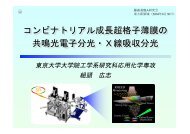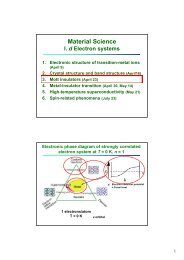Thesis High-Resolution Photoemission Study of Kondo Insulators ...
Thesis High-Resolution Photoemission Study of Kondo Insulators ...
Thesis High-Resolution Photoemission Study of Kondo Insulators ...
Create successful ePaper yourself
Turn your PDF publications into a flip-book with our unique Google optimized e-Paper software.
40 Chapter 3. <strong>Photoemission</strong> <strong>Study</strong> <strong>of</strong> YbB12 with Variable Photon Energies<br />
to the higher binding energy side <strong>of</strong> the peak. The low-energy-scale components, Σl(ω)<br />
and Σl ′(ω) were necessary to reproduce the steep rise in the vicinity <strong>of</strong> EF . As a result,<br />
the negative slope <strong>of</strong> ReΣ(ω) increases as one approaches EF . This in turn increases<br />
|ImΣ(ω)| away from EF through the KK relation, which explains how the DOS peak<br />
at ∼0.3 eV in the LDA is smeared out and results in the asymmetric single peak in<br />
the measured spectrum. The resulting |ImΣ(ω)| shows a V-shaped lineshape near EF ,<br />
a reminiscent behavior <strong>of</strong> the marginal Fermi liquid proposed by Varma et al. [3.25].<br />
In Fig. 3.6, the quasi-particle DOS N ∗ (ω) ≡ ρf(ω)(1 − ∂ReΣ(ω)/∂ω) is also plotted by<br />
the dot-dashed curve.<br />
To establish the relationship between the <strong>Kondo</strong> effect and the formation <strong>of</strong> the<br />
semiconducting gap on microscopic grounds is beyond the scope <strong>of</strong> the present phenomenological<br />
approach. In the renormalized band picture, the <strong>Kondo</strong> peak and the<br />
semiconducting gap are influenced by the different regions <strong>of</strong> the self-energy with different<br />
slopes ∂ReΣ(ω)/∂ω. However, this does not exclude the possibility that the<br />
disappearance <strong>of</strong> the local moment and that <strong>of</strong> spectral weight at ω ∼ 0 in the optical<br />
conductivity show parallel temperature dependence as in Ce3Bi4Pt3 [3.2] because the<br />
electrical conductivity and the magnetic susceptibility have characteristic temperatures<br />
<strong>of</strong> similar magnitudes: Eact/kB ∼ Tmax. In the local description <strong>of</strong> the <strong>Kondo</strong> insulator<br />
by Kasuya [3.4], the Yb 4f hole forms a singlet bound state with a conduction<br />
electron, the binding energy being given by kBTK. The local <strong>Kondo</strong> picture and the<br />
renormalized f-band picture should be complementary to each other, describing the<br />
different phenomena <strong>of</strong> the same correlated insulator starting from the different, i.e.,<br />
localized and itinerant, limits. How the transport gap and the <strong>Kondo</strong> peak change with<br />
temperature or with electron doping (in Yb1−xLuxB12) studied by PES would give further<br />
valuable information about the gap formation. Direct observation <strong>of</strong> quasi-particle<br />
dispersions using a single crystal by angle-resolved PES is also an important future<br />
subject. Finally, we remark that the strong energy dependence <strong>of</strong> mass renormalization<br />
may not be unique to the <strong>Kondo</strong> insulators but may be a general phenomenon<br />
in valence-fluctuating f-electron systems because strong asymmetry has also been reported<br />
for metallic YbAgCu4 [3.12] and YbAl3 [3.10].






